Located in the southeastern region of the US, Virginia is known for its vast and diverse habitats. The stunning Chesapeake Bay, the Shenandoah Valley, and numerous rivers, mountains, and forests, there is something there for everyone to explore. However, if you’re out exploring, it’s important to take care as there are 32 snakes in the state, with three being venomous. One of these is the cottonmouth – also known as the water moccasin. So, join us as we discover everything you need to know about cottonmouths in Virginia!
Identifying Cottonmouths
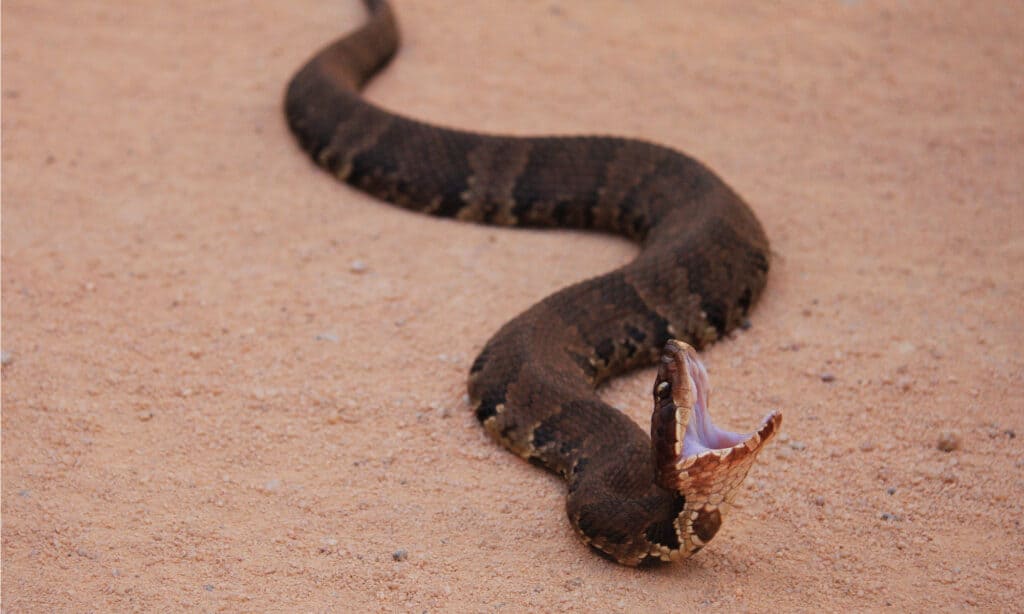
Cottonmouths are named for the white interior of their mouth that resembles cotton.
©Nathan A Shepard/Shutterstock.com
There are two species of cottonmouth snakes – the northern and the Florida cottonmouth. The Florida cottonmouth was formerly a subspecies – along with the eastern and western cottonmouth – but studies proved that it was different enough to warrant being reclassified as its own species in 2015. That left the other two subspecies to become simply the northern cottonmouth. The Florida cottonmouth is native only to Florida and parts of Georgia, while the northern cottonmouth is fairly widespread across the rest of the southeastern US. The northern cottonmouth is the species that is native to Virginia, but for the rest of this article, we’ll simply call them cottonmouths.
Cottonmouths are fairly large snakes at 30 to 43 inches long. They have dark brown to black bodies, which are overlaid with darker crossbands. Sometimes these snakes can have a particularly dark ground color which makes the crossbands indistinguishable. However, juvenile cottonmouths are usually tan with reddish-brown crossbands and a yellow tail.
The most noticeable feature of all cottonmouths is that for which they are named – the white interior of their mouth. When they are threatened, cottonmouths often coil their bodies and open their mouth wide in a defensive position to ward off any would-be predators. When their mouth gape open, it exposes the white lining, which resembles cotton.
Where do Cottonmouths Live in Virginia?
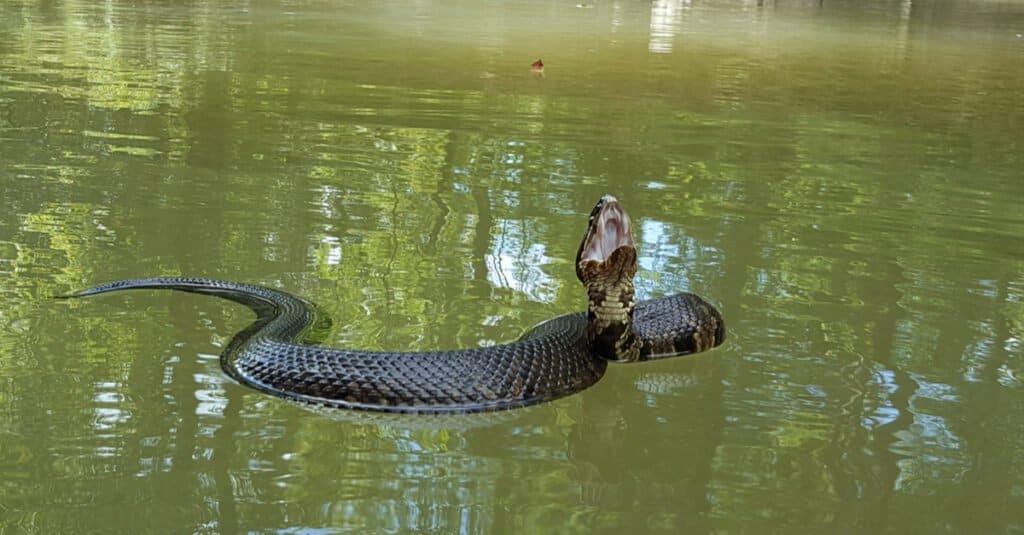
Cottonmouths can be found wherever there is fresh water including lakes, ponds, rivers, and streams
©Seth LaGrange/Shutterstock.com
Cottonmouths are semi-aquatic snakes and spend much of their lives in water. Even when they are not in the water, they rarely stray far from it – most often spotted basking on logs or rocks nearby, where they can easily flee to the safety of the water if they are disturbed.
Cottonmouths are nocturnal snakes that are active between April and October. They live in virtually any freshwater wetland habitat – such as rivers, lakes, ponds, streams, swamps, and even drainage ditches. However, they are not found across the entire state of Virginia. Instead, cottonmouths only occur in the southeastern corner, with most populations living south of the James River. These snakes are most abundant in the Chesapeake and Virginia Beach regions, but there are also populations in the counties of Brunswick, Chesterfield, Dinwiddie, Greensville, Prince George, Southampton, Surrey, Sussex, and York.
Cottonmouth Venom
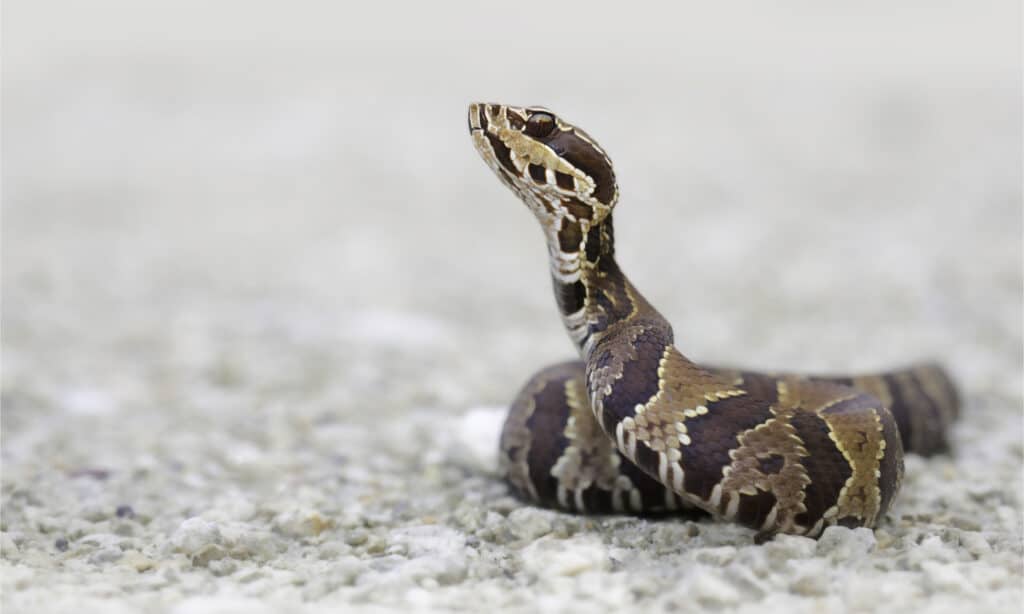
Cottonmouths are venomous snakes.
©Kristian Bell/Shutterstock.com
Although most venomous snakes are harmful to humans, just how much of a threat they pose comes down to which type of venom they contain and how much venom they can inject per bite (venom yield).
There are four main types of venom – cytotoxic, neurotoxic, hemotoxic, and proteolytic – and these all attack the body differently. Cottonmouths possess cytotoxic venom, which attacks and destroys tissue. Although this type of venom is not usually as deadly as the other types, it can cause extensive – even life-changing injuries. In many cases, cottonmouth venom can cause extensive scarring, and in some cases, the necrosis can be so bad that the entire limb has to be amputated.
Cottonmouths also contain a lot of venom. They inject around 125mg of venom, although sometimes this can be as much as 237mg. Since we’ve just mentioned that their venom is not as deadly as other types, between 100 and 150mg of this venom is still enough to kill a human. Additionally, it’s not just adult cottonmouths that you need to watch out for, as juveniles still contain a lot of venom too.
How Dangerous are Cottonmouths in Virginia?
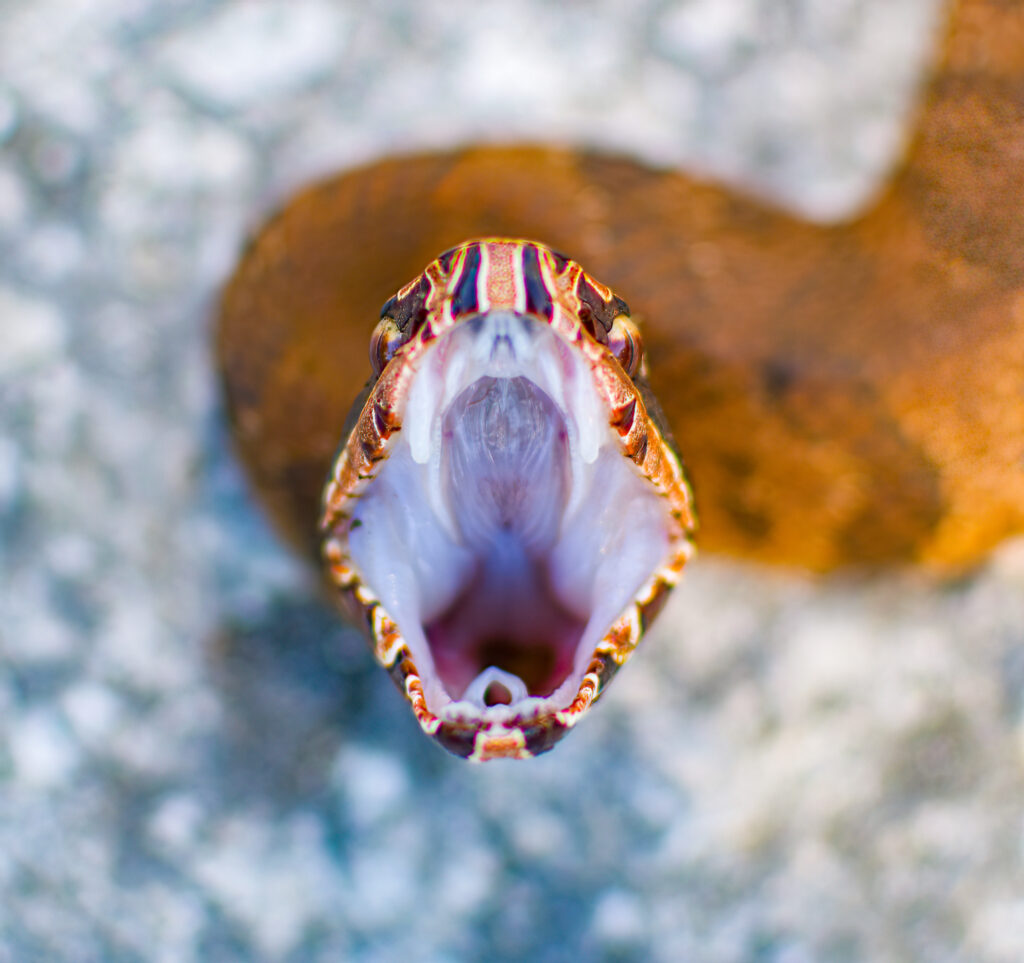
Cottonmouths are responsible for 1% of venomous snake bites in the US and 7.3% in their immediate environment
©iStock.com/Chase D’animulls
Although there are no reliable records to go on to determine just how dangerous cottonmouths are in Virginia, we can still look at the overall figures that we have to hand.
Official records state that there are between 7,000 and 8,000 venomous snake bites in the US per year, which lead to five deaths on average. Of these, only 1% are attributed to cottonmouths. However, if we look only at the known range of the cottonmouth, then the total percentage rises to 7.3%. Despite this, the chance of dying from a cottonmouth bite is still pretty low on average.
What Should You Do if You See or Are Bitten by A Cottonmouth?
Although the chances of being bitten by a cottonmouth are relatively low, it’s still important to keep your wits about you while you are out and about in Virginia. There are also a few steps that you can take to minimize your risk of being bitten.
Most snake bites – from any snake – happen when the snake is accidentally stepped on or is threatened in some way. Therefore, it’s really important to watch where you tread – particularly when you are stepping over logs and rocks. Also, never put your hands into a crevice or anywhere that you can’t see what is in there. Additionally, as cottonmouths are often in the water, it’s important to watch out for them there too. When swimming, they tend to hold their head up above the water while their body skims along the top.
If you happen to see a cottonmouth, these snakes prefer to flee to safety than stand their ground and attack you. Therefore, you should always back away and give the snake room to escape – preferably back to the water.
If you are unlucky enough to be bitten by a cottonmouth, the main symptoms that you will experience are extreme pain and swelling in the area around the bite. Even if you don’t think that your symptoms are serious, you should always get medical assistance immediately. This is because, for the best results, anti-venom should be administered within six hours – although within one hour is preferable.
Similar Aquatic Snakes in Virginia
Considering that there are a lot of snakes in Virginia, it’s not surprising that there are a few that look like cottonmouths – mainly water snakes. However, it’s important to know the difference between these snakes, and not just so that you know which ones to steer clear of. This is because some people mistake the water snakes for cottonmouths and actively hunt or kill them – simply because of a case of misidentification.
Northern Water Snake (Nerodia sipedon)
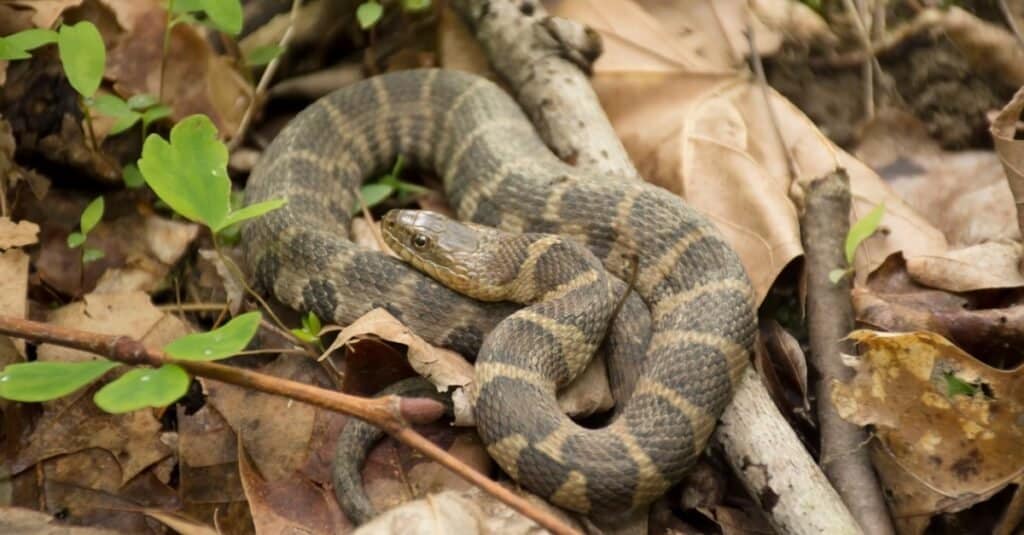
The northern water snake has a flat head that is as wide as its neck.
©iStock.com/IcemanJ
The northern water snake is the snake that is most often mistaken for the cottonmouth. These snakes range between 24 and 54 inches long and have brown to black bodies overlaid with darker crossbands on their necks and blotches on their bodies. Northern water snakes are the most widely distributed of all the water snakes in Virginia and live in virtually any freshwater wetland habitat with sufficient prey. Although they are not venomous, they readily bite when threatened or handled. Their saliva contains a mild anti-coagulant which makes any wounds inflicted by them bleed quite a lot.
Brown Water Snake (Nerodia taxispilota)
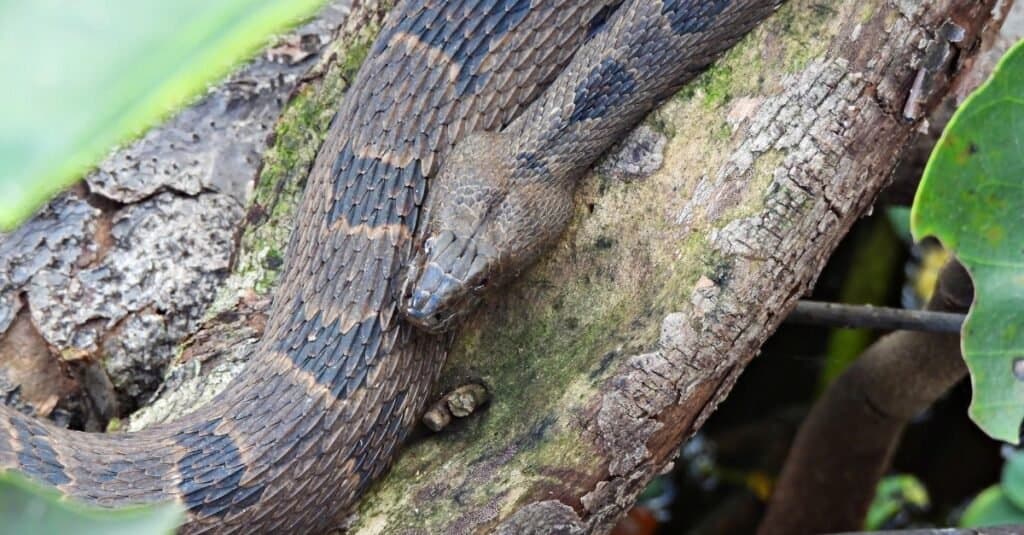
Brown water snakes have a triangular head, with the eyes being set toward the top.
©iStock.com/passion4nature
The largest of the water snakes in Virginia is the brown water snake which is usually 30 to 60 inches long, although it can be longer. These snakes have brown bodies with around 25 black or dark brown blotches across their backs. Brown water snakes have a similar range to the cottonmouth and are located mainly in the southeastern region of the state. However, they tend to prefer to live in rivers and streams.
Plain-Bellied Water Snake (Nerodia erythrogaster)
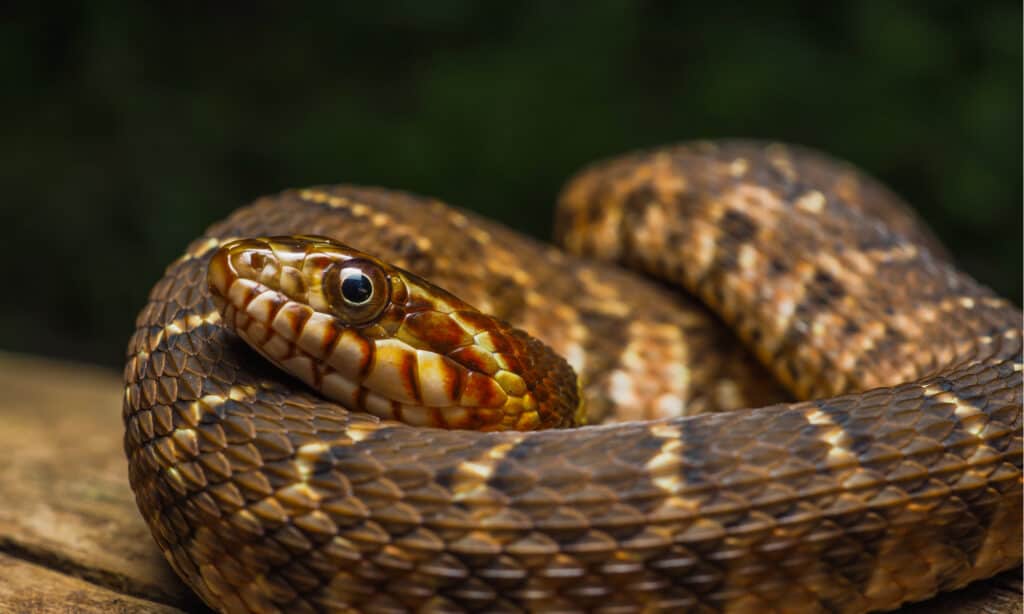
Plain-bellied water snakes live in wetland regions within the southeastern corner of Virginia.
©Tyler Albertson/Shutterstock.com
The final water snake is the plain-bellied water snake. Plain-bellied water snakes are 24 to 40 inches long and have thick, heavy bodies. They are usually a solid gray, green, brown, or black on their dorsal side with a plain yellow or cream-colored belly. These snakes live in wetland regions within the southeastern corner of Virginia. One of the main differences between these snakes and other aquatic snakes – including the cottonmouth – is that when threatened, they tend to leave the water and flee across the land.
What State Has the Most Snake Bites?
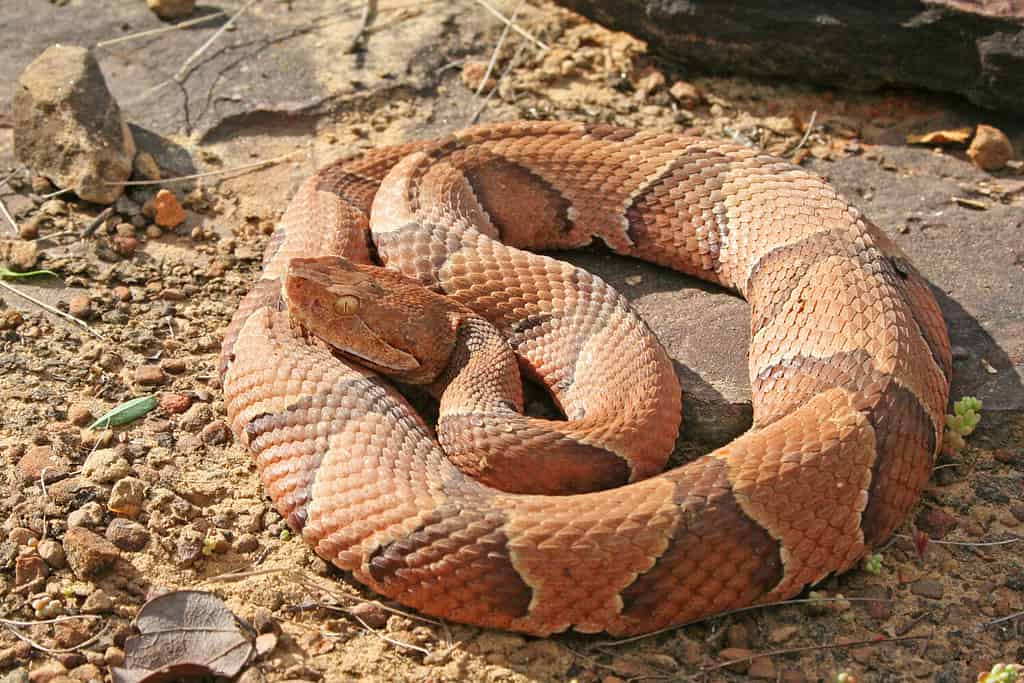
The venomous copperhead snake is among the snakes responsible for snake bites in North Carolina.
©Creeping Things/Shutterstock.com
In Virginia, which ranks 5th for the most snake bites annually per U.S. state, there are an estimated 48.7 bites per million population reported per year. But what state ranks the highest in snake bites? That would be North Carolina. This southeastern state’s bite rate is 157.8 bites per million population per year. How does that average out? Well, the population as of 2021 was a little over 10 million (10.55 to be exact). If we were to just figure it off of 10 million, that would mean that there are roughly 1,580 reported snake bites per year.
The top 6 states for reported snake bites are as follows:
- North Carolina–157.8 bites per million
- West Virginia–105.3 bites per million
- Arkansas–92.9 bites per million
- Oklahoma–61 bites per million
- Virginia–48.7 bites per million
- Texas–44.2 bites per million
In North Carolina, there are 6 different kinds of venomous snakes: copperhead, cottonmouth, timber rattlesnake, pigmy rattlesnake, eastern diamondback rattlesnake, and eastern coral snake. In 2019, 92 people were bitten by venomous snakes in that state.
The photo featured at the top of this post is © Marcum Havens/Shutterstock.com
Discover the "Monster" Snake 5X Bigger than an Anaconda
Every day A-Z Animals sends out some of the most incredible facts in the world from our free newsletter. Want to discover the 10 most beautiful snakes in the world, a "snake island" where you're never more than 3 feet from danger, or a "monster" snake 5X larger than an anaconda? Then sign up right now and you'll start receiving our daily newsletter absolutely free.
Sources
- National Library of Medicine, Available here: https://www.ncbi.nlm.nih.gov/books/NBK546645/
- Center for Disease Control and Prevention, Available here: https://www.cdc.gov/niosh/topics/snakes/default.html#:~:text=Each%20year%2C%20an%20estimated%207%2C000,than%20to%20die%20from%20them.
- Live Science, Available here: https://www.livescience.com/43597-facts-about-water-moccasin-cottonmouth-snakes.html#:~:text=%22Like%20all%20pit%20vipers%2C%20%5B,which%20is%20often%20potential%20prey.
- Virginia DWR, Available here: https://dwr.virginia.gov/blog/snakes-on-the-water
- Virginia DWR, Available here: https://dwr.virginia.gov/wildlife/information/eastern-cottonmouth/
- Virginia Herpetological Society, Available here: https://www.virginiaherpetologicalsociety.com/reptiles/snakes/cottonmouth/cottonmouth.php
Thank you for reading! Have some feedback for us? Contact the AZ Animals editorial team.






